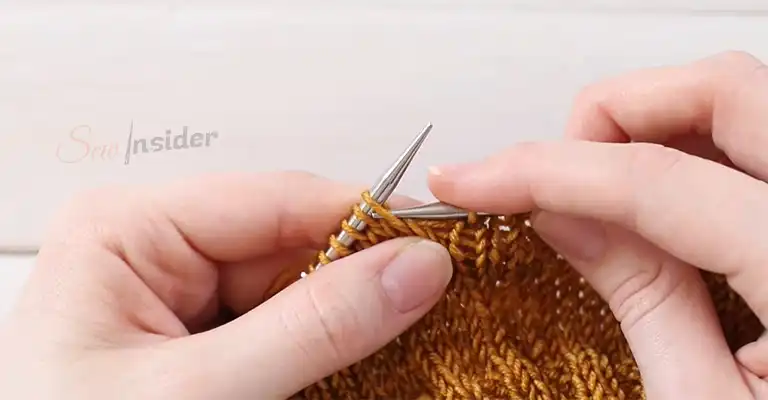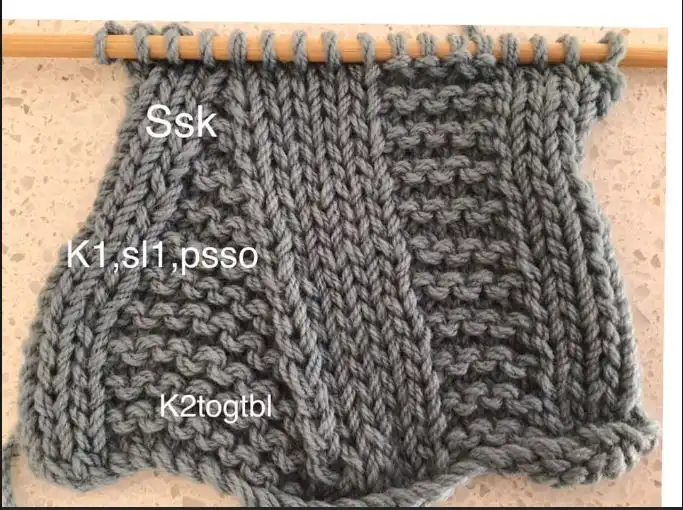Knitting is an art; every artist needs the right tools and techniques. If we’re examining the world of knitting, we have likely come across the intriguing abbreviation SL1-K1-PSSO. In this guide, I’ll unravel SL1-K1-PSSO, breaking down each step into simple, digestible pieces. By the end, you’ll understand the concept and master it, adding a new dimension to your knitting range.

Understanding SL1-K1-PSSO

Now, let’s decode the secret language of SL1-K1-PSSO. This abbreviation breaks down into three simple steps: slip one stitch, knit the next stitch, and pass the slipped stitch over the knitted one. Sounds easy, right?
Let’s break it down even further.
- Slip 1 Stitch: Gently move one stitch from the left needle to the right without knitting it.
- Knit 1 Stitch: Work your magic and knit the next stitch as usual.
- Pass Slipped Stitch Over (PSSO): This is the crucial step. Take the slipped stitch and pass it over the knitted one. You’ve just performed SL1-K1-PSSO!
Tools Needed
Before going to the details of SL1-K1-PSSO, gather your essentials. All you need are some quality yarn and a pair of knitting needles. Choosing the right combination will set the stage for your knitting success.
Practice Makes Perfect
Beginners fear not! Start with simple SL1-K1-PSSO patterns to hone your skills. With consistent practice, you’ll notice a remarkable improvement. Don’t hesitate to unravel and start over – it’s all part of the knitting journey.
Incorporating SL1-K1-PSSO in Projects
Now that you’ve mastered SL1-K1-PSSO let’s explore its applications.
Certainly! The “sl1-k1-psso” (slip 1, knit 1, pass slipped stitch over) decrease is a versatile technique that can add a decorative touch to various knitting projects. Here are some ways you can incorporate it into your projects:
- Lace Patterns:
- Use “sl1-k1-psso” in lace patterns to create delicate and intricate designs. The left-leaning decrease adds a subtle elegance to openwork stitches and helps shape the lace.
- Decreasing Stitches:
- When you need to decrease stitches and want a decorative effect, “sl1-k1-psso” is a great choice. It slants to the left, providing a nice contrast if paired with a right-leaning decrease like “k2tog.”
- Edging Details:
- Incorporate “sl1-k1-psso” along the edges of your project to create a decorative border. This can add a polished and finished look to items like scarves, shawls, and blankets.
- Textured Patterns:
- Combine “sl1-k1-psso” with other stitch patterns to create textured fabric. For example, alternate rows of “sl1-k1-psso” with plain knit or purl rows to form interesting textures.
- Headbands and Accessories:
- Add a touch of sophistication to headbands, wrist warmers, or other accessories by using “sl1-k1-psso” in strategic places. This can elevate simple projects into more stylish and refined pieces.
- Center Panel in Scarves or Shawls:
- Create a focal point in scarves or shawls by using “sl1-k1-psso” to shape a center panel. This draws attention to the design and gives your project a unique flair.
- Dishcloths with Flair:
- Even practical items like dishcloths can benefit from a touch of elegance. Incorporate “sl1-k1-psso” in a pattern to make your dishcloths more interesting and visually appealing.
Advanced SL1-K1-PSSO Techniques
Here are some advanced SL1-K1-PSSO techniques:
- Double Decrease:
- Combine “sl1-k1-psso” with other decreases to create a double decrease. For example, slip one stitch, knit two stitches together (k2tog), and pass the slipped stitch over both knit stitches. This forms a more pronounced central decrease.
- Twisted or Slipped Stitches:
- Experiment with twisting or slipping stitches in different ways before performing the “sl1-k1-psso.” This can create unique textures and visual effects in your knitting.
- Yarn Over (YO) Combinations:
- Integrate yarn overs with “sl1-k1-psso” to add lace-like elements. For instance, slip one stitch, yarn over, knit one stitch, pass slipped stitch over (sl1-yo-k1-psso). This combination creates an eyelet next to the decrease.
- Reversed SL1-K1-PSSO:
- Try reversing the order of the basic decrease. Knit one stitch, slip one stitch knitwise, pass the slipped stitch over (k1-sl1-psso). This creates a right-leaning decrease and can be used in combination with left-leaning decreases for a balanced look.
- Cable Combinations:
- Pair “sl1-k1-psso” with cable stitches to create intricate cable patterns. The decrease can be part of the cable twist, adding complexity to your knitted cables.
- Colorwork Integration:
- Incorporate “sl1-k1-psso” into colorwork projects for added interest. Experiment with using different colors for the slipped stitch, creating a contrasting effect.
- Cluster Decreases:
- Group “sl1-k1-psso” decreases together to form clusters. For example, slip one stitch, knit one stitch, pass slipped stitch over, slip one stitch, knit one stitch, pass slipped stitch over—repeat. This creates a cluster of decreases for a more textured appearance.
- Varied Stitch Counts:
- Adjust the number of stitches between each “sl1-k1-psso” decrease. Varying the stitch counts can result in a more irregular or organic look in your knitting.
Benefits of SL1-K1-PSSO
Beyond the elegance it adds to your projects, SL1-K1-PSSO enhances your overall knitting skills. It’s a versatile technique that every knitting enthusiast should have in their repertoire. Benefits are:
- Elegance
- Versatility
- Balancing decreases
- Textural interest
- Skill building
- Crisp decrease lines
- Customization
- Creativity
- Enhanced lace knitting skills
- Efficient stitch reduction
What if I drop a stitch during SL1-K1-PSSO?
If a stitch is dropped during SL1-K1-PSSO, pause immediately and secure your work. Retrieve the dropped stitch with a crochet hook or spare needle, reposition it correctly, and continue the decrease. Check for errors, adjust tension if needed, and mark the repaired area. Be vigilant to prevent future drops, regularly checking your work for mistakes as you knit. With practice, you’ll become more skilled at addressing and fixing dropped stitches efficiently.
Can SL1-K1-PSSO be used in all knitting patterns?
While SL1-K1-PSSO (slip 1, knit 1, pass slipped stitch over) is a versatile and commonly used decrease in many knitting patterns, it may not be suitable for all projects. Its left-leaning effect adds elegance and is often employed in lace patterns or to shape garments. However, specific patterns or designs may call for different decreases to achieve the desired look or balance. It’s essential to follow the instructions of each pattern, as different decreases serve distinct purposes in creating varied textures and appearances in knitted fabric.
Conclusion
In the world of knitting, mastering SL1-K1-PSSO opens a realm of creativity. This left-leaning decrease, with its elegant touch, enhances various projects. Start with the basics, understanding each step. Progress to advanced techniques, adding texture and depth. Embrace its versatility in lace, garments, and accessories. Practice, fix mistakes, and watch your skills grow. While SL1-K1-PSSO isn’t universal, its benefits make it a valuable addition, enriching your knitting journey with style and proficiency.
Leave a Reply